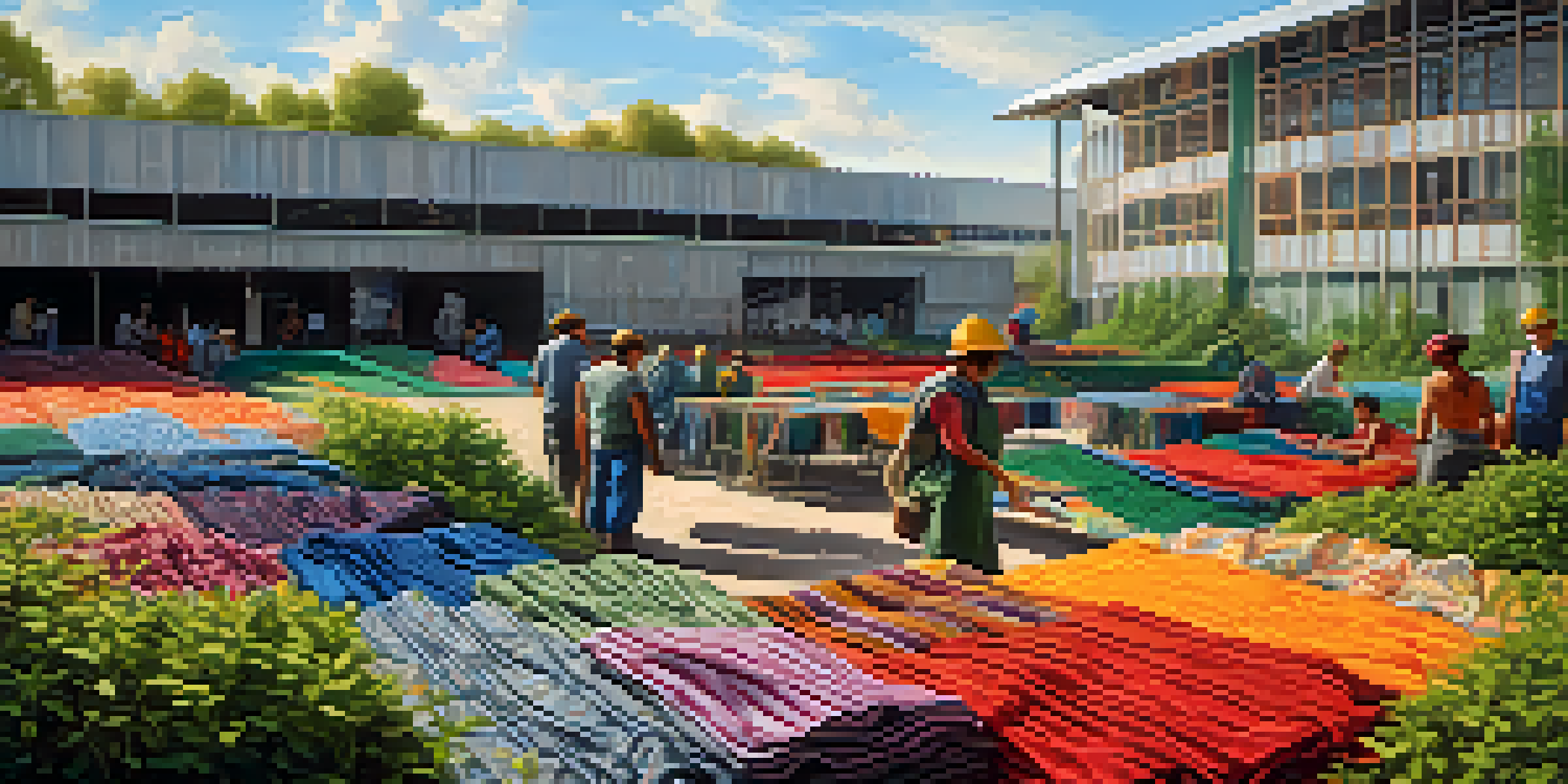The Impact of Textile Waste on Landfills and Oceans

Understanding Textile Waste: A Growing Concern
Textile waste refers to discarded clothing and fabric that often ends up in landfills or oceans. With the rise of fast fashion, the amount of textile waste generated has skyrocketed. In fact, the Environmental Protection Agency (EPA) reported that in 2018 alone, about 17 million tons of textile waste were created in the U.S. alone. This staggering statistic highlights the urgent need to address our consumption habits and the lifecycle of our clothing.
The greatest threat to our planet is the belief that someone else will save it.
You might think that throwing away an old shirt is harmless, but the reality is far more troubling. Many materials used in clothing, such as polyester and nylon, take hundreds of years to decompose. As they break down, they release harmful chemicals into the soil and waterways, further polluting the environment. This scenario paints a vivid picture of the consequences of our fashion choices.
Moreover, the sheer volume of textile waste contributes to overflowing landfills, which can lead to land and water contamination. As consumers, we have the power to change this narrative by being mindful of our purchases and considering sustainable options. By understanding the impact of textile waste, we can start taking steps toward a more eco-friendly wardrobe.
The Journey of Textile Waste to Landfills
When clothing is discarded, it often makes its way to landfills, where it becomes a long-lasting problem. Landfills are designed to contain waste, but they are not equipped to handle the unique challenges posed by textiles. Many items, especially those made from synthetic materials, can take decades or even centuries to break down, contributing to the ever-growing waste crisis.

In addition to the physical space they occupy, textiles in landfills produce methane, a potent greenhouse gas that contributes to climate change. This happens during the decomposition process, especially in anaerobic environments where there’s little oxygen. It's a stark reminder that our old clothes can have far-reaching consequences, impacting not just our local environment but the planet as a whole.
Textile Waste is a Growing Problem
The rise of fast fashion has led to millions of tons of textile waste, significantly impacting landfills and the environment.
To combat this issue, many organizations are advocating for better waste management practices and recycling initiatives. By donating or recycling our old clothing, we can help reduce the burden on landfills and promote a more sustainable approach to fashion. The choices we make today can significantly alter the trajectory of textile waste in the future.
How Textile Waste Affects Our Oceans
The journey of textile waste doesn’t end in landfills; it often finds its way into our oceans as well. According to a report by the Ellen MacArthur Foundation, around 35% of all microplastics in the ocean come from the washing of synthetic textiles. These tiny fibers are not only harmful to marine life but also enter the food chain, affecting wildlife and humans alike.
We do not inherit the earth from our ancestors; we borrow it from our children.
Marine animals often mistake these microplastics for food, leading to ingestion that can cause internal injuries or even death. This issue is particularly concerning for species like fish, which are crucial for both ecosystem health and human consumption. The impact on biodiversity is immense, and it’s a haunting reminder of how our clothing habits can ripple through the ecosystem.
Efforts to address this issue include initiatives to develop sustainable fabrics and technologies that minimize fiber shedding. By choosing natural fibers or brands that prioritize sustainability, consumers can play a vital role in reducing textile waste in our oceans. It’s a collaborative effort that requires awareness and action from both producers and consumers.
The Role of Fast Fashion in Textile Waste
Fast fashion has revolutionized the clothing industry, but it comes at a significant environmental cost. Brands produce low-cost, trendy items at a rapid pace, encouraging consumers to buy more than they need. This constant cycle of consumption leads to a significant increase in textile waste, as garments are discarded after only a few wears.
Many consumers are unaware of the environmental implications of their shopping habits. The thrill of finding a bargain often overshadows the reality that these items contribute to a larger problem. By prioritizing trends over sustainability, the fast fashion industry perpetuates a cycle of waste that harms our planet.
Impact on Oceans and Marine Life
Textile waste contributes to ocean pollution, with microplastics from synthetic fabrics harming marine ecosystems and entering the food chain.
To combat this issue, it’s essential for consumers to shift their mindset. Embracing slow fashion, which emphasizes quality over quantity and sustainability over disposability, can help reduce textile waste. By supporting ethical brands and making informed choices, we can all contribute to a healthier planet.
Innovative Solutions to Textile Waste
As the issue of textile waste becomes more prominent, innovative solutions are emerging to tackle the problem. One approach is textile recycling, where old garments are transformed into new materials. This process not only reduces waste but also decreases the demand for virgin resources, making it a win-win situation for the environment.
Another solution gaining traction is upcycling, where discarded textiles are creatively repurposed into new products. From turning old jeans into trendy bags to transforming bed linens into stylish home decor, upcycling offers a unique way to breathe new life into old items. This not only diverts waste from landfills but also promotes creativity and individuality.
Additionally, many brands are beginning to implement take-back programs, encouraging consumers to return their old clothing for recycling or repurposing. By actively participating in these initiatives, consumers can help close the loop in the fashion industry, creating a more sustainable future for textile production and disposal.
Consumer Responsibility: Making Sustainable Choices
As consumers, we hold significant power in influencing the textile industry. By making conscious choices about what we buy and wear, we can help reduce textile waste and its environmental impact. Simple actions, like choosing quality over quantity and opting for sustainable brands, can make a huge difference over time.
Moreover, educating ourselves about the lifecycle of our clothing can empower us to make informed decisions. Understanding where our clothes come from, how they're made, and their ultimate fate can help us align our purchasing habits with our values. This awareness is the first step toward becoming a more responsible consumer.
Consumer Choices Matter
By making sustainable fashion choices and participating in recycling initiatives, consumers can help reduce textile waste and its environmental consequences.
Participating in local clothing swaps or thrift shopping can also promote sustainability while providing unique fashion finds. By sharing resources and extending the lifespan of garments, we can collectively reduce our impact on landfills and oceans. Together, we can create a movement toward more sustainable fashion practices.
The Future of Textile Waste Management
The future of textile waste management hinges on innovation, collaboration, and consumer awareness. As more people recognize the urgency of the textile waste crisis, we can expect to see an increase in sustainable practices across the industry. Brands are beginning to prioritize eco-friendly materials and ethical production methods, which is a positive step forward.
Government regulations and policies can also play a crucial role in reducing textile waste. By implementing stricter guidelines on waste management and encouraging recycling initiatives, we can create a more sustainable infrastructure for the fashion industry. This collaborative effort will require commitment from all stakeholders, including manufacturers, retailers, and consumers.

Ultimately, the responsibility to reduce textile waste lies with all of us. By staying informed, making sustainable choices, and advocating for better industry practices, we can contribute to a healthier planet for future generations. Together, we can pave the way for a more sustainable future in fashion.